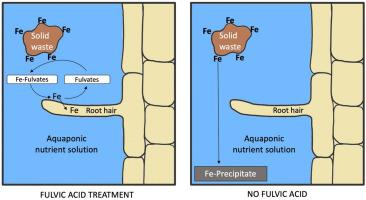当前位置:
X-MOL 学术
›
Aquacult. Eng.
›
论文详情
Our official English website, www.x-mol.net, welcomes your
feedback! (Note: you will need to create a separate account there.)
Fulvic acid increases iron bioavailability in aquaponic systems: theoretical designs and practical considerations to prevent iron deficiency in plants
Aquacultural Engineering ( IF 3.6 ) Pub Date : 2020-08-01 , DOI: 10.1016/j.aquaeng.2020.102091 Brunno da Silva Cerozi
Aquacultural Engineering ( IF 3.6 ) Pub Date : 2020-08-01 , DOI: 10.1016/j.aquaeng.2020.102091 Brunno da Silva Cerozi

|
Abstract Plants grown in aquaponics frequently develop iron deficiency, which is generally corrected via supplementation with iron chelates. However, the solid waste excreted by fish contains considerable amounts iron, which are lost in the system by precipitation of insoluble iron oxides. Thus, the present study proposed the use of fulvic acid (FA), a humic substance with metal complexing capacity, to prevent iron precipitation and enhance its bioavailability in the aquaculture wastewater. An aquaponic solution was added with levels of fulvic acid (0, 69, 138, 345, and 690 mg L−1), and analyzed for dissolved iron after incubation and centrifugation. Visual MINTEQ was used to characterize and quantify the effect of fulvic acid levels on iron precipitation, species of possible solid forms, and concentration of dissolved bioavailable iron forms. Dissolved iron concentration increased with the inclusion of fulvic acid in the nutrient solution, and the highest iron concentration (22.4 μM) was obtained by treating the solution with 690 mg L−1 of fulvic acid. Visual MINTEQ simulations demonstrated that, in the absence of fulvic acid, iron precipitated in the form of αFe2O3, and the concentration of available iron increased with the inclusion of FA due to its complexing properties. Solution pH had no effect on iron availability with the absence of fulvic acid; in its presence, the effect of pH was only significant at values below 4.5. This study shows that fulvic acid seems to play an important role in transporting low-soluble iron from fish tanks to plant roots in aquaponic systems.
中文翻译:

富里酸提高鱼菜共生系统中铁的生物利用度:防止植物缺铁的理论设计和实际考虑
摘要 在鱼菜共生中生长的植物经常出现缺铁现象,这通常通过补充铁螯合物来纠正。然而,鱼类排泄的固体废物中含有大量的铁,这些铁会通过不溶性氧化铁的沉淀而在系统中流失。因此,本研究建议使用富里酸 (FA),一种具有金属络合能力的腐殖质,防止铁沉淀并提高其在水产养殖废水中的生物利用度。在鱼菜共生溶液中加入黄腐酸(0、69、138、345 和 690 mg L-1),并在孵育和离心后分析溶解的铁。Visual MINTEQ 用于表征和量化富里酸水平对铁沉淀、可能的固体形式的种类和溶解的生物可利用铁形式的浓度的影响。溶解铁浓度随着营养液中富里酸的加入而增加,通过用 690 mg L-1 的富里酸处理溶液获得最高的铁浓度(22.4 μM)。视觉 MINTEQ 模拟表明,在没有富里酸的情况下,铁以 αFe2O3 的形式沉淀,并且可用铁的浓度随着 FA 的络合特性而增加。在没有富里酸的情况下,溶液的 pH 值对铁的可用性没有影响;在它存在的情况下,pH 值的影响仅在低于 4.5 时才显着。这项研究表明,富里酸似乎在将低溶性铁从鱼缸运输到鱼菜共生系统中的植物根部方面发挥着重要作用。通过用 690 mg L-1 的富里酸处理溶液获得最高的铁浓度 (22.4 μM)。视觉 MINTEQ 模拟表明,在没有富里酸的情况下,铁以 αFe2O3 的形式沉淀,并且可用铁的浓度随着 FA 的络合特性而增加。在不存在富里酸的情况下,溶液 pH 值对铁的可用性没有影响;在它存在的情况下,pH 值的影响仅在低于 4.5 时才显着。这项研究表明,富里酸似乎在将低溶性铁从鱼缸运输到鱼菜共生系统中的植物根部方面发挥着重要作用。通过用 690 mg L-1 的富里酸处理溶液获得最高的铁浓度 (22.4 μM)。视觉 MINTEQ 模拟表明,在没有富里酸的情况下,铁以 αFe2O3 的形式沉淀,并且可用铁的浓度随着 FA 的络合特性而增加。在不存在富里酸的情况下,溶液 pH 值对铁的可用性没有影响;在它存在的情况下,pH 值的影响仅在低于 4.5 时才显着。这项研究表明,富里酸似乎在将低溶性铁从鱼缸运输到鱼菜共生系统中的植物根部方面发挥着重要作用。铁以 αFe2O3 的形式沉淀,由于 FA 的络合特性,有效铁的浓度随着 FA 的加入而增加。在不存在富里酸的情况下,溶液 pH 值对铁的可用性没有影响;在它存在的情况下,pH 值的影响仅在低于 4.5 时才显着。这项研究表明,富里酸似乎在将低溶性铁从鱼缸运输到鱼菜共生系统中的植物根部方面发挥着重要作用。铁以 αFe2O3 的形式沉淀,由于 FA 的络合特性,有效铁的浓度随着 FA 的加入而增加。在不存在富里酸的情况下,溶液 pH 值对铁的可用性没有影响;在它存在的情况下,pH 值的影响仅在低于 4.5 时才显着。这项研究表明,富里酸似乎在将低溶性铁从鱼缸运输到鱼菜共生系统中的植物根部方面发挥着重要作用。
更新日期:2020-08-01
中文翻译:

富里酸提高鱼菜共生系统中铁的生物利用度:防止植物缺铁的理论设计和实际考虑
摘要 在鱼菜共生中生长的植物经常出现缺铁现象,这通常通过补充铁螯合物来纠正。然而,鱼类排泄的固体废物中含有大量的铁,这些铁会通过不溶性氧化铁的沉淀而在系统中流失。因此,本研究建议使用富里酸 (FA),一种具有金属络合能力的腐殖质,防止铁沉淀并提高其在水产养殖废水中的生物利用度。在鱼菜共生溶液中加入黄腐酸(0、69、138、345 和 690 mg L-1),并在孵育和离心后分析溶解的铁。Visual MINTEQ 用于表征和量化富里酸水平对铁沉淀、可能的固体形式的种类和溶解的生物可利用铁形式的浓度的影响。溶解铁浓度随着营养液中富里酸的加入而增加,通过用 690 mg L-1 的富里酸处理溶液获得最高的铁浓度(22.4 μM)。视觉 MINTEQ 模拟表明,在没有富里酸的情况下,铁以 αFe2O3 的形式沉淀,并且可用铁的浓度随着 FA 的络合特性而增加。在没有富里酸的情况下,溶液的 pH 值对铁的可用性没有影响;在它存在的情况下,pH 值的影响仅在低于 4.5 时才显着。这项研究表明,富里酸似乎在将低溶性铁从鱼缸运输到鱼菜共生系统中的植物根部方面发挥着重要作用。通过用 690 mg L-1 的富里酸处理溶液获得最高的铁浓度 (22.4 μM)。视觉 MINTEQ 模拟表明,在没有富里酸的情况下,铁以 αFe2O3 的形式沉淀,并且可用铁的浓度随着 FA 的络合特性而增加。在不存在富里酸的情况下,溶液 pH 值对铁的可用性没有影响;在它存在的情况下,pH 值的影响仅在低于 4.5 时才显着。这项研究表明,富里酸似乎在将低溶性铁从鱼缸运输到鱼菜共生系统中的植物根部方面发挥着重要作用。通过用 690 mg L-1 的富里酸处理溶液获得最高的铁浓度 (22.4 μM)。视觉 MINTEQ 模拟表明,在没有富里酸的情况下,铁以 αFe2O3 的形式沉淀,并且可用铁的浓度随着 FA 的络合特性而增加。在不存在富里酸的情况下,溶液 pH 值对铁的可用性没有影响;在它存在的情况下,pH 值的影响仅在低于 4.5 时才显着。这项研究表明,富里酸似乎在将低溶性铁从鱼缸运输到鱼菜共生系统中的植物根部方面发挥着重要作用。铁以 αFe2O3 的形式沉淀,由于 FA 的络合特性,有效铁的浓度随着 FA 的加入而增加。在不存在富里酸的情况下,溶液 pH 值对铁的可用性没有影响;在它存在的情况下,pH 值的影响仅在低于 4.5 时才显着。这项研究表明,富里酸似乎在将低溶性铁从鱼缸运输到鱼菜共生系统中的植物根部方面发挥着重要作用。铁以 αFe2O3 的形式沉淀,由于 FA 的络合特性,有效铁的浓度随着 FA 的加入而增加。在不存在富里酸的情况下,溶液 pH 值对铁的可用性没有影响;在它存在的情况下,pH 值的影响仅在低于 4.5 时才显着。这项研究表明,富里酸似乎在将低溶性铁从鱼缸运输到鱼菜共生系统中的植物根部方面发挥着重要作用。











































 京公网安备 11010802027423号
京公网安备 11010802027423号